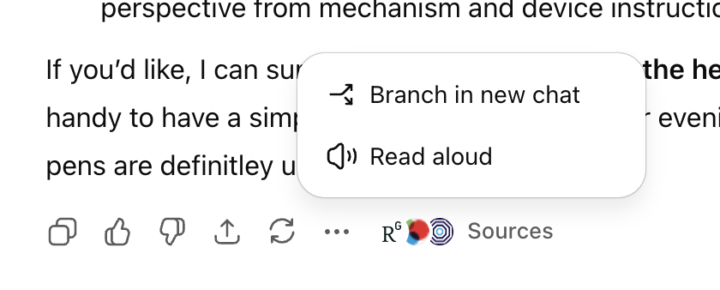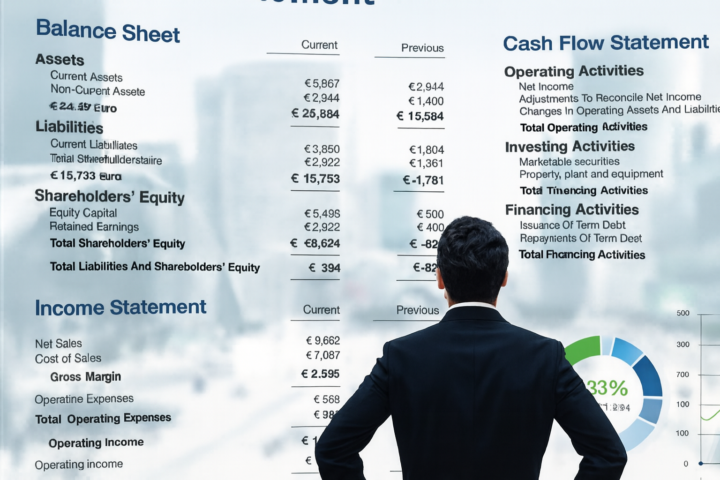Activity
Mon
Wed
Fri
Sun
Oct
Nov
Dec
Jan
Feb
Mar
Apr
May
Jun
Jul
Aug
Sep
What is this?
Less
More
Memberships
AI Community
1.1k members • Free
12 contributions to AI Community
🌿 New ChatGPT Feature: Branch in New Chat
OpenAI released a brand-new feature on 4th September... you can now branch conversations in ChatGPT. That means if you want to take a chat in a different direction, you don’t have to lose your original thread. Just hover over a message, click More actions (⋯), and select Branch in new chat to start fresh from that point. 📸 (See the screenshot below for how it looks) This is available today for all logged-in users on web. 👉 Have you spotted this feature yet? How do you think you’ll use it? I’ll be honest... I’m still struggling to find super practical use cases myself, but if I do, I’ll let you know. In the meantime, I’d love to hear your ideas on where branching could really help.

📢 Projects Are Now on the Free Tier
Big news from OpenAI... Projects are now available to everyone, including the Free tier! Projects let you keep your chats and files together in one place, so you can stay focused and organised. Here’s what’s new: - Free tier: Projects included, with up to 5 file uploads per project - Plus, Go, and Edu: Up to 25 files per project - Pro, Business (Team Plan), and Enterprise: Up to 40 files per project - All plans: New customisation options like colours and icons to help keep your projects tidy This makes it easier than ever to keep your work structured... whether you’re on the Free plan or running multiple projects on higher tiers. 👇 What do you think... will you start using Projects to manage your work?
🙏 Please help me by watching this video: How to Get the Best from ChatGPT
I’ve just launched a brand-new YouTube channel called AI Community—and I need your help to get it up and running. I’ve uploaded the first video, and it’s all about why ChatGPT 5 feels both brilliant and frustrating—and the simple strategies that make it work so much better. 👉 [Click here to watch the video] If you can: 1. Watch the video 2. Hit the 👍 like button 3. Subscribe to the channel 4. Leave a quick comment under the video …it would mean a huge amount. Every little bit of support helps the channel grow in these early days. Thank you! 🙌
🖼️ GPT-5 Struggles with Text in Images
Here’s something important to know if you’re creating images in ChatGPT. I ran the same prompt in two models: - GPT-5 → full of spelling mistakes ❌ - GPT-4o (legacy) → perfect text ✅ 👉 Tip: When you need images that include text (like posters, social posts, or graphics), switch to one of the legacy models in your settings. They handle text much more accurately than GPT-5. 📸 (See both examples below)

⚖️ The EU AI Act Is Now Law — What It Means for Accounting Firms
From 2 August 2025, new rules under the EU AI Act will directly affect how accountants use tools like ChatGPT, Claude, and Gemini—especially if you operate in the EU or serve EU-based clients. Here’s what small firm owners need to know (wherever you’re based): ✅ What You Need to Do 1. Be Transparent with Clients If you use AI to generate insights, draft reports, or summarise accounts, you must let clients know—either in the final deliverable or engagement letter. 2. Avoid Prohibited Uses The following are banned, even for internal use: - Emotional profiling - Behavioural manipulation - Biometric surveillance (e.g. emotion detection or facial recognition) 3. Complete a Risk Assessment Each use of AI needs to be classified: - Minimal risk (e.g. summarising public info): little action needed - Limited risk (e.g. AI-assisted report drafting): requires documentation and transparency - High risk (e.g. credit scoring, fraud detection): needs human oversight and strict controls Most AI use in small firms will fall into the limited risk category. 4. Apply the Same Logic as GDPR Treat AI tools like you treat personal data: - Record what you use, when, and why - Note who reviews AI outputs - Add disclaimers or checks where needed 5. Choose Compliant Tools Use AI platforms that: - Offer enterprise-grade security - Allow opt-outs from training - Ideally use EU-based data processing Good options: ChatGPT Team or Enterprise, Claude via Amazon Bedrock, or a local model via Ollama. 🌍 Regional Differences EU Firms: Full compliance required. Treat it like GDPR—document, assess, disclose. UK Firms : If you serve EU clients, the Act applies. If not, you’re exempt—but similar UK guidelines may still apply. Canada / US: You’re only affected if you serve EU clients or use EU-based tools—but similar laws are coming. 🧭 Practical Example A firm in Ireland must fully comply. A firm in the UK must comply only if it serves EU clients. A firm in Canada is exempt—unless it processes EU data or uses EU tools.
1-10 of 12
@teresa-slack-9672
Teresa is a Certified Professional Bookkeeper and the co-founder of Financly Inc., an award-winning firm specializing in E-commerce Accounting.
Active 3d ago
Joined May 15, 2025
Powered by


